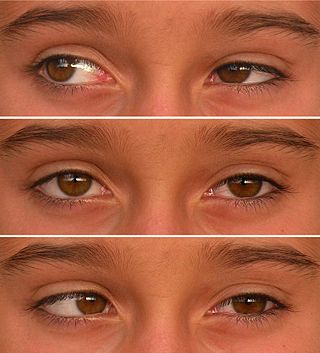Related Research Articles

Duane syndrome is a congenital rare type of strabismus most commonly characterized by the inability of the eye to move outward. The syndrome was first described by ophthalmologists Jakob Stilling (1887) and Siegmund Türk (1896), and subsequently named after Alexander Duane, who discussed the disorder in more detail in 1905.

Axenfeld–Rieger syndrome is a rare autosomal dominant disorder, which affects the development of the teeth, eyes, and abdominal region.

Class III β-tubulin, otherwise known as βIII-tubulin (β3-tubulin) or β-tubulin III, is a microtubule element of the tubulin family found almost exclusively in neurons, and in testis cells. In humans, it is encoded by the TUBB3 gene.

Paired mesoderm homeobox protein 2A is a protein that in humans is encoded by the PHOX2A gene.

Kinesin-like protein KIF21A is a protein that in humans is encoded by the KIF21A gene.

X-linked spinal muscular atrophy type 2, also known as arthrogryposis multiplex congenita X-linked type 1 (AMCX1), is a rare neurological disorder involving death of motor neurons in the anterior horn of spinal cord resulting in generalised muscle wasting (atrophy). The disease is caused by a mutation in UBA1 gene and is passed in an X-linked recessive manner by carrier mothers to affected sons.
References
- 1 2 Engle, E.C., Genetic Basis of Congenital Strabismus. Arch Ophthalmol. 2007;125(2):189 article
- ↑ Tischfield MA, Baris HN, Wu C, Rudolph G, Van Maldergem L, He W, Chan WM, Andrews C, Demer JL, Robertson RL, Mackey DA, Ruddle JB, Bird TD, Gottlob I, Pieh C, Traboulsi EI, Pomeroy SL, Hunter DG, Soul JS, Newlin A, Sabol LJ, Doherty EJ, de Uzcátegui CE, de Uzcátegui N, Collins ML, Sener EC, Wabbels B, Hellebrand H, Meitinger T, de Berardinis T, Magli A, Schiavi C, Pastore-Trossello M, Koc F, Wong AM, Levin AV, Geraghty MT, Descartes M, Flaherty M, Jamieson RV, Møller HU, Meuthen I, Callen DF, Kerwin J, Lindsay S, Meindl A, Gupta ML Jr, Pellman D, Engle EC (2010). "Human TUBB3 mutations perturb microtubule dynamics, kinesin interactions, and axon guidance". Cell. 140 (1): 74–87. doi:10.1016/j.cell.2009.12.011. PMC 3164117 . PMID 20074521.
{{cite journal}}: CS1 maint: multiple names: authors list (link) - ↑ Laughlin, R.C. Congenital fibrosis of the extraocular muscles; a report of six cases. Amer J Ophthalmol 41, 432-438 (1956).
- ↑ Baumgarten, M. Erfahrungen uber den strabismus und die Muskeldurchschneidung am Auge in physiologischpathologischer und therapeutischer Beziehung. Monatsschr Med Augenheilkd Chir 3, 474-499 (1840).